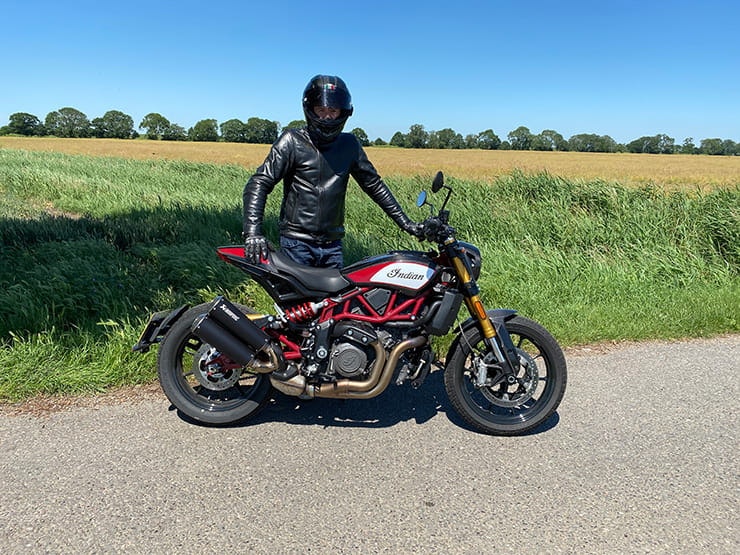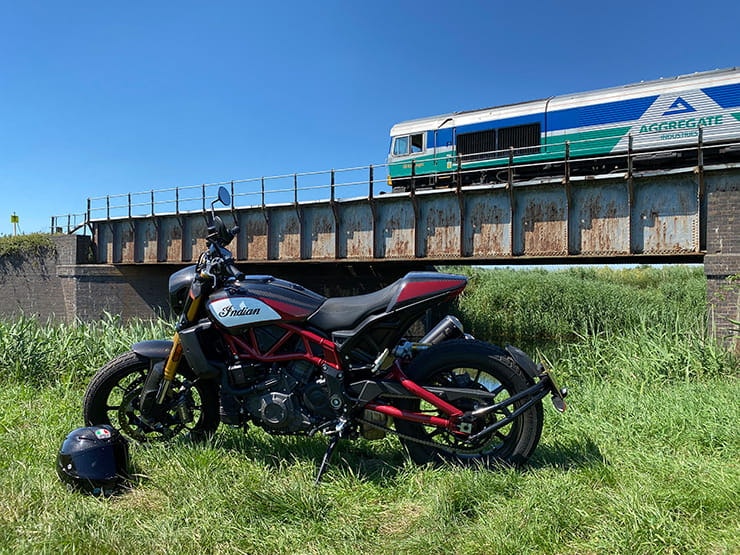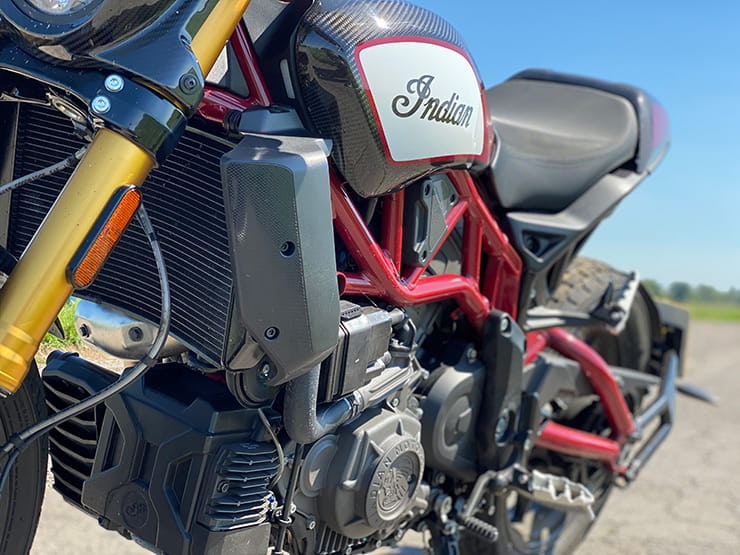Indian FTR 1200 Carbon (2020) - Review
By Michael Mann
BikeSocial Managing Editor
10.07.2020
KIT CREDITS
Helmet
AGV Pista GP-R Matt Carbon: £899.99 | www.agv.co.uk
Jacket
Dainese Settantadue Chiodo £429.95 | www.dainese.com
Jeans
Dainese Strokesville £209.95 | www.dainese.com
Boots
Dainese Metropolis: £139.95 | www.dainese.com
Gloves
Dainese X-Strike: £149.95 | www.dainese.com
Overview
“Indian made a brave move to step away from the types of bike it’s famed for – the cruisers and big tourers - with a move to expand its market with the FTR range, an aggressive/retro streetfighting line-up, it’s a bit like Coca Cola starting to make swimming goggles. Since coming to the market, the model has been popular, particularly the ‘S’ over the stock version with its adjustable suspension, IMU and TFT display as the main differences, and it’s destined to attract a younger audience.
The carbon finish will divide opinion with some preferring the strand-out carbon weave to the more ordinary finish on the stock model or even the ‘S’, it adds to the uniqueness of an already uncommon machine, though you’d have to be warped if you don’t prefer the black Akrapovic silencers – they’re gorgeous!”
Refreshingly entertaining
Aggressive but not uncomfortable riding position
Matt finish on the touch screen – very helpful
Hideous number plate holder
Grim finish on the collector box
Strange choice of wheel size and rubber; style over substance
The FTR1200 range was unveiled in a plume of dramatic smoke at the Intermot show at the back end of 2018 before making into dealerships in early 2019. Inspired by the FTR 750 race bike which has been dominating the US flat track scene in recent years Indian Motorcycles’ street version nicked the template of an engine from its sister, the Scout, and came in two forms; a standard model and the more popular ‘S’. Fast forward twelve months and the firm announced this, the Indian FTR Carbon – an upgraded version of the S model with carbon fibre body work components and a top spec, low-mounted, over-and-under Akrapovic with the blacked-out finish. This is the most premium model in the range and comes with a price tag to underline that.
The model isn’t supposed to be limited edition but we understand just 35 will make it into the UK each year and in our book, you’d be unlucky to pull up alongside another – unless it’s an FTR owners convention.
So, a week with the daringly different FTR Carbon was my reward for being so patient during lockdown. Here’s what I thought.
2020 Indian FTR Carbon
The road-going hooligan is back! In it's fourth and range -topping variation, the FTR1200 adds more bling with a Carbon look.
2020 Indian FTR Carbon Price
A £14,699 price tag to takeaway this Indian is £1700 above the S model and that slots it between a Triumph Thruxton RS and Ducati Monster 1200 S – its nearest couple of rivals.
It’s only available in this red/carbon finish, also known as Race Replica which pays homage its glory-filled flat track roots.
Power and torque
Above: Low-slung and rather snug 60-degree V-Twin
With a peak power output of 125bhp at 8250rpm, the FTR is no superbike but is not slouch either. It won’t compete on paper with a similarly-sized twin in the shape of the Monster 1200 but the way in which it catapults itself out of corners and away from the lights low down in the rev range will have very few, if any, complaining at a lack of grunt, making it manageably mad and highly entertaining too.
However, the hearty peak torque figure of 120Nm is indeed superbike sized, and can be found relatively early in the range too, at 5900rpm whereas the red line is up at 9,000rpm, thus giving a big shove-in-the-back amount of go in the mid-range.
Ignore any pre-conceptions of American twins being lazy, lethargic and only good for cruising, the FTR spits in your face, kicks up some dust like an angry short man and offers a lively, well-connected and excitable throttle connection with instant power delivery. Instant, yes. Smooth? Er, stay clear of Sport mode if you prefer to live without whiplash. Much like the rest of the bike, it’s keen to dispel myths.
Above: working the angles but with a very obvious 'better' side
Engine, gearbox and exhaust
The motor is 80% new versus the very-similar-to-the-naked-eye Scout engine and while it’s still a 60-degree V-twin, this 1203cc heartbeat has a sack full of alternative internals from rods and cams to pistons and cylinder head ports. It sits low in this long wheelbase machine and its steel trellis chassis and that in turn sinks the balance of the bike nicely towards the ground, in unison with the actual fuel tank which sits below the saddle instead of the more traditional location in between the knees. All of which is designed to enhance performance and handling, something the FTR750 race machine is rather good at, hence its successes in the USA.
The beefy surge of power from low in the rev range is an absolute hoot, addictive too. My first 30-miles or so were aimed deliberately at the bouncy Fenland b-roads not only to analyse the suspension but to see how the Indian’s chassis handled itself. I was pleasantly surprised by how neat everything felt, from the throttle reaction to instant gush of acceleration to glide me over the undulations. Despite having a long wheelbase for stability, the V-Twin didn’t read the rule book and instead encourages the front wheel to rise up at any and every opportunity. It isn’t wild and uncontrollable but more like an eager Labrador pub keen for affection.
Clunking up and down the non-quickshifter assisted gearbox is precise and reassuringly mechanical. There’s an old-school charm about the solid feel of the gear lever and its accuracy while the clutch lever and its resistance isn’t the solid mass you’d perhaps associate with a burly American. Things were looking up.
For all the huff and puff under acceleration from low-mid range, the FTR offers a different and more gentle cruising-style for the more sedate rides. A set of over-and-under 2-1-2 Akrapovic pipes give the bike some extra pizazz from a side-on visual perspective though you wouldn’t know they were anything special on sound alone which somewhat strangles the V-Twin orchestra we want to listen to – get the baffles out if you dare.
One point to note too, as instructed by Indian’s marketing man, the bike needs a bit of old-fashioned warming up before setting off. For those with more mechanical sympathy than impatient journalists
2020 Indian FTR Carbon Economy
The 12.9 litre tank sits under the rider’s saddle for better weight distribution and therefore handling, and from it I eeked 100 miles from a tank full which equates to around 42mpg. Not mega but more fuel capacity means more weight and this FTR Carbon isn’t designed for big cruising miles, it’s a rabid road reveller and if you can put up with the patience required to fill it up then it’s so worth it. Because the fuel cap is in the traditional place yet the tank is under the seat, gravity has to intervene and work a little harder to get the bike brimmed. It’s a minor discrepancy.
Handling, suspension, chassis and weight
Part of this bold appearance is the 19” front and 18” rear wheel combination to mimic the flat track style but that nullifies sporty handling somewhat. Indian then equipped the big rims with specially-designed Dunlop DT3R rubber – again, flat-track inspired. These semi-knobblies are a strange choice with style very much the focus over substance. None the less, front end grip is far better than you’d expect once you’ve gained the confidence to push past your expectations. An aggressive riding position with plenty of leg room despite the apparently high pegs, plus wide, thick handlebars promote a front-end focus on cornering too.
The centre of gravity is cleverly helped with the fuel tank placement under the seat and it appears so neatly put together with a short, flat body and long wheelbase with pegs situated under the bum. The downside to which is looking the bike from the non-exhaust side or even a rear ¾ that shows the awful number plate holder, reminiscent of scaffolding. An official high licence plate mount is available at around £275 which looks better, reduces weight but still sticks out beyond the rear tyre (as it legally should).
Speaking of weight, at 228kg the FTR is the heaviest in its class and while it’s certainly sturdy and that weight can be felt in the slower corners, it’s by no means unhandleable. The front steers well and I’ve already mentioned its inclination to detach itself from the ground, while the rear is quite the opposite. It would much rather be slip-sliding around though it’s not a deal-breaker and is only a concern if you poke the bear. And poking is easier in Sport mode with its alternate and quite fighty throttle connection.
The riding position is very handy for the type of riding the FTR is keen to demonstrate. The bars are wide and because it’s a slight reach, it encourages your chin to be over the back of the front tyre which moves that centre of gravity forwards to compensate for the fuel tank position, and that means a livelier rear end. The turning circle is ace and the seat height is adjustable too, between 815mm and 853mm. The saddle itself is nicely sculpted and well finished too, a credit to bottoms everywhere.
Adjustable Sachs suspension on the FTR Carbon replicates that on the S with easy-to-access adjusters on the top of the forks. In their standard setting I found them very well suited for those bouncy b-roads – possibly the most noticeable point on my first ride.
For this market, I think a 750 version that’s a lot lighter and potentially even A2 compliant would be a bigger seller, something to challenge the MT-07, MT-09, 790 or 890 Duke. But, then again, I’m sure Indian are more than happy with their brand position for this model as a premium machine to compete with the likes of Ducati, for example.
Brakes
Stopping will never be as exciting as going although is just as important. Thankfully, the Indian Motorcycles brake department worked a blinder by choosing a pair of 320mm Brembo-assisted discs to do the work. They’re strong and purposeful with a lever feel with enough resistance and feel to make the experience reassuring. Take the ABS off and with a little practice you too can float the rear, stoppie style! In fact, bang on the rear brake without ABS and you can slide just like your BMX days aged 13.
2020 Indian FTR Carbon comfort over distance and touring
It may be a little obvious but the FTR1200 line-up is a naked range and therefore it has no wind protection. Some bikes in this category come with little cowls that perform a little wind deflection, a Tuono 1100 for example, but not the case on the FTR – it blasts straight into your chest like no other. Thankfully a screen and mounting kit isn’t too expensive from the official accessories range. In fact, stick a screen and a bit of luggage on and you’ve got a bike that’ll cover some miles in comfort too. The seat and riding position is well thought out with a lovely saddle and appropriate-for-the-style triangle between handlebar, foot peg and seat front to encourage a sporty-ish stance without too much wrist weighting. The controls are small, basic and in winter gloves may be trickier to operate but they’re positioned perfectly for an easy reach.
Tall, stem-like mirrors aren’t particularly attractive to look at but remain vibe-free from the V-Twin chortling beneath. Easy to adjust but the range of adjustability particularly with left mirror isn’t perfect.
Be warned if you plan on venturing out in the wet – with a low-set number plate hanger and lack of mudguard, the back of your jacket will be a muck magnet.
Rider aids and extra equipment / accessories
For a 2020 machine, the level of sophistication isn’t immediately apparent. Climb on board and the rather solid-looking and Gameboy-esque, Bluetooth-enabled TFT display isn’t surrounded in the most chic manner but what it does is far better. Touch screen technology (whilst stopped only) works well even with gloved hands and allows for quick adjustments to the riding mode or to turn off TC and ABS, or just to flick between screens. It can be manipulated on the fly by a variety of options - with the a flick of your right index finger on the button inside the throttle, using the joystick on the left-side or via the buttons adjacent to the screen. It’s easy to read too with a matt finish to disperse any sun glare. Clever. Though it doesn’t offer any economy figures.
Three riding modes are easy to swap between - Sport, Standard, Rain with bespoke throttle responses and traction control intervention levels. A 6-axis IMU controls lean sensitive traction control and ABS while the bike is also equipped with a handy USB port under the TFT display, a sip/ assist clutch and LED lights.
Grips are large and very, er, grippy although the clutch lever is non-adjustable. That would make sense if the bike had a quick shifter making the lever near enough redundant. And while I’m pointing out the not-so-great bits, how’s the ignition barrel placing? If you carry more than one key then you’re snookered, and good luck trying to get the parking lock on.
Plenty of good-looking official accessories are available via the website including loads of luggage options but interestingly wire spoke wheels are an option at around £1000, plus importantly, a low screen and mounting kit at £300.
Rivals
Most mainstream manufacturers will have a suitable naked with which we can compare to the FTR Carbon yet it is still a fairly unique proposition – a retro-styled streetfighter with a sack full of low torque, sporty riding position and plenty of gadgets. As a package, it’s as entertaining to ride as a supernaked and so I’ve picked a handful of rivals to fit into the usual table but there are plenty of others out there including BMW’s Rnine T range and two alternative Triumphs – namely the Scrambler 1200 or Speed Triple RS. Take components and character from all three and you end up with this Indian.
2020 Indian FTR Carbon Verdict
Decidedly fresh and daringly different, this retro-fashioned, aggressively-entertaining streetbike is a gem to ride. It’ll take a little getting used to because it’s not what you might expect from its appearance, and it’s certainly not what you’d think a brand like Indian would offer but kudos to them because it’s both bold and brilliant. It has little practical value and you wouldn’t want to spend hours in the saddle but as a functional piece of transportation, it puts a smile on your face whether you’re hooning around the back roads or being more conservative in town. The low-down beefy torque, quality of finish and bark from the V-Twin are a tidy yet tough trio of tremendous and tantalising treats. It certainly stands-out from the crowd.
The front end feels light and direct, though needs little encouragement to wheelie with a little throttle tease in second gear. So, if you can justify the price and have your fiendish face on, then get yourself a test ride.
Then, we can all petition Indian to make an adventure spec version. Nothing too dramatic though, a bit of bodywork and some longer travel suspension but with the charisma retained.
2020 Indian FTR Carbon Specs
Looking for motorbike insurance? Get a quote for this bike with Bennetts motorcycle insurance


